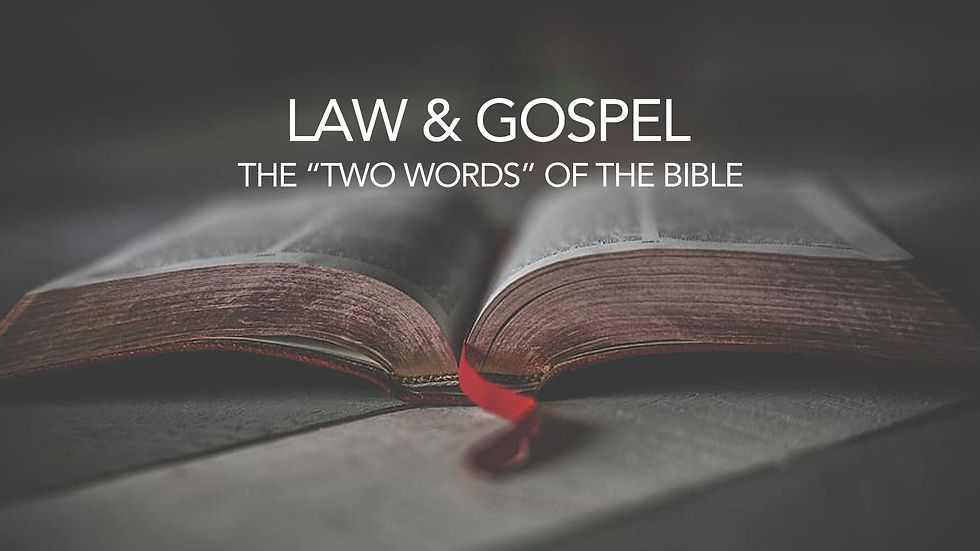The Visible God (Jn.14:1-12)
- Mark A. Smith
.JPG/v1/fill/w_320,h_320/file.jpg)
- Feb 7, 2024
- 3 min read

God of God, Light of Light, very God of very God
In continuation of “And in one Lord Jesus Christ, the only-begotten Son of God, begotten of the Father before all worlds,” we come now to the more defined and refined confession of the nature and person of Jesus Christ in distinction from the creation itself (Ps.12:6). This confession “God of God, Light of Light, very God of very God” speaks to the truth that the soul of Christ is not human but eternally divine according to the character of God’s perfections without any defections at all or in any corruptible way (Isa.1:14; 42:1). Jesus is God of God (Isa.53:11), not a god of God (Jer.6:8; 31:14; 32:41). He is not human with a divine nature (Zech.11:8), but is “the divine nature” that has taken human nature to “himself,” (that is, the flesh), not the corruptibility of a human soul (Heb.1:1-4; Jn.1:1-2, 14), which was the nature of Adam’s soul as a “creation” of the Creator (Heb.1:5-14), but the likeness of the corruption of flesh and blood demonstrated that “His soul” could not be corrupted by it (Acts 2:27, 31; Heb.10:5; Rom.8:3; Phil.2:7). Jesus is God of God and the God of gods through Whom the gods have received the Word of God (Jn.10:35-36; Ps.82; Dan.11:36; Dt.10:17; Jos.22:22; Ps.136:2), and by which the human nature is transformed and conformed (metamorphoses/transubstantiate) into the divine nature by the gift of the Holy Spirit as God had decreed from before the foundation of the world (Rom.8:28-30; Matt.25:34; Lk.11:50; Jn.17:24; Eph.1:4; Heb.4:3; 9:26; 1Pet.1:20), through the Lamb of God as one slain (Rev.13:8; 17:8; Jn.1:29, 36; Rev.5:6; 7:17; 14:10; 15:3; 19:9; 21:23), making a new race of spiritual men made perfect and incorruptible like Himself (1Jn.3:2; Heb.12:22-24; 1Cor.2:9-16), and as His own special possession through the shedding of His own blood (1Pet.1:17-19; 2:9-10).
Now, this “Light of Light” signifies the inner nature of the Man who came in the body as a lamp of the revelation of the Father (Matt.6:22-23; 12:33; Lk.11:33-36). Jesus Christ is “the” Light of the world (Jn.8:12; 9:5), not the light that illuminates the world (Jn.11:9; 2Cor.14-15; Eph.5:13), but the Light that gives life to the world (Jn.8:12; 1Cor.15:45; Jn.6:33, 51, 63), for the light of nature destroys (Rom.9:18; Heb.3:13; Job.38:37-38; Rom.1:18-21), but the Light of God is eternal life (1Jn.1:5-7), and in (that) life there is no darkness at all (Jn.1:4-9; 1Jn.5:10-13).
Therefore, this Christ alone is God of very God who doesn’t need to be “morphed” into the divine nature as we must (Jn.3:6-8; Ps.51:5-6), for it is He who was the incorruptible Seed (Gen.3:15; Gal.3:16, 19; Rom.9:6-8), which was sowed into the corruptible seed by the Holy Spirit through the virgin birth (Lk.1:26-35; Matt.1:18-25), whereby we put on incorruptibility that we may have our life in the life of God (1Cor.15:42-57), and for this reason, Jesus Christ is the Beginning (Rev.1:8; 21:6; 22:13), “our beginning,” (according to eternal life with God) and the End (1Cor.15:45; Eph.2:14-18), “our end,” (according to sin in our misery of death) because He came into the world as the Firstborn among many brethren to pour into us the glory of the life of God (Rom.8:29; Col.1:15, 18; Heb.1:6; 11:28; 12:23), having “our beginning” in Him to the praise and to the highest glory of God our Father blessing all things in Jesus Christ as the Lord of glory (Ps.89:27; Rev.1:5; Eph.1:3-14; 1Cor.2:8; James.2:1).
“[A place is given to both types of profession in the Gelasian Sacramentary, which is considered to reflect Roman liturgical practice in the sixth century. Here the renunciation of Satan appears, as we might expect, at an early point in the service, and is carried out with the thrice-repeated cry “I renounce (abrenuntio)”. Then comes the creed in its declaratory form. As child baptism was by now all but universal, the rubric enjoins it to be said by the priest with his hand on the children’s heads. All this happens outside the actual baptistery, and is followed by a series of prayers and liturgical acts. Then in the baptistery the font is elaborately blessed, and the rubric continues. This has been, of necessity, a rapid and incomplete review of a confusing array of evidence. There is no task in the field of liturgies which deserves higher priority to-day than the sorting out of the baptismal and associated rites, and the elaboration of a constructive theory of their evolution. What has been said, however, should be sufficient to prove that declaratory creeds had an assured position in the baptismal service (understanding this in the widest sense) at any rate from the fourth century.]”
J. N. D. Kelly, Early Christian Creeds, Third Edition. (London; New York: Continuum, 2006), 37-38.























Comments